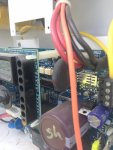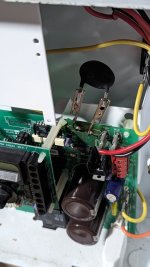After thinking about the issues I've had with the thermistor on my Hayward SWG and researching on the forum and google...I came across a mention about an external thermistor.
Hmmmm.... So that got me thinking.
What if you could solder a couple of leads from the pin where each leg of the thermistor solders into? On the other end of each lead - just have a receptacle that each leg of the thermistor could plug into? Essentially just making a pigtail or extension - and then just run it to the side of the main board. That way if you need to replace, or even just test the thermistor, you'd only have to take off the two screws to the main panel. It'd be as easy as changing out a fuse.
I'm definitely not an electrical engineer, so I have no clue on the specs or what gauge the leads should be - but for anyone familiar with all that jazz, could it be done without blowing up my house??
Hmmmm.... So that got me thinking.
What if you could solder a couple of leads from the pin where each leg of the thermistor solders into? On the other end of each lead - just have a receptacle that each leg of the thermistor could plug into? Essentially just making a pigtail or extension - and then just run it to the side of the main board. That way if you need to replace, or even just test the thermistor, you'd only have to take off the two screws to the main panel. It'd be as easy as changing out a fuse.
I'm definitely not an electrical engineer, so I have no clue on the specs or what gauge the leads should be - but for anyone familiar with all that jazz, could it be done without blowing up my house??





